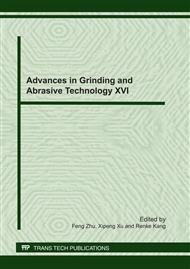p.429
p.433
p.438
p.443
p.447
p.452
p.457
p.462
p.468
Research on Surface Residual Stress of Nano-Composite Ceramics under Multi-Frequency Ultrasonic Grinding and Dressing
Abstract:
The surface residual stress of nano-composite ceramics prepared by mixed coherence system and machined both in ordinary grinding(OG) and ultrasonic vibration grinding(TDUVG) respectively were described. Researches showed that the characteristics of residual stress on ceramic surface is affected by grinding load, ultrasonic vibration frequency and released stress induced by generation of cracks whose magnitude is affected by material removal mechanism. Whether in ordinary grinding or ultrasonic grinding, tangential residual stress (TRS) in X direction is tensile stress, and in Y direction is compressive stress. The surface residual tensile stress in ordinary grinding is larger than that in ultrasonic grinding with the same grinding conditions. The influences of multi-frequency on the residual stress are studied.
Info:
Periodical:
Pages:
447-451
Citation:
Online since:
July 2011
Authors:
Price:
Сopyright:
© 2011 Trans Tech Publications Ltd. All Rights Reserved
Share:
Citation:


